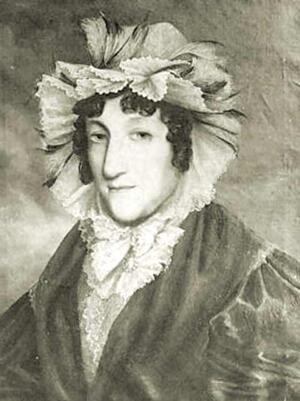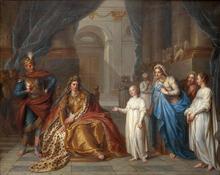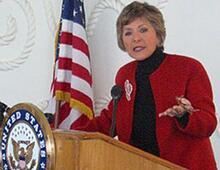Esther Abrahams
Convicted of stealing lace from a London store in 1786, Esther Abrahams was transported to Australia for a term of seven years’ penal servitude, and arrived there along with her baby daughter early in 1788. She is an iconic figure in Australian history, having almost immediately upon arrival become the lover, and much later the wife, of a Scottish marine officer who rose to be one of the wealthiest and most powerful men in the colony of New South Wales. For a time he was its unofficial governor, with the astute and resourceful Esther as first lady, a remarkable destiny for a former convict girl.
On August 30, 1786, at the Old Bailey, London's criminal court, Esther Abrahams was charged with having stolen “privily,” on July 27 that year, 24 yards of black silk lace worth almost 50 shillings from a large haberdashery shop near Piccadilly. The nowadays non-existent quaint charge of “stealing privily” meant pilfering surreptitiously—not in plain view—and carried the death penalty. When Esther stood in the dock to face her accusers, she was in the early stages of pregnancy, although it is doubtful that she yet knew it.
Transported for Theft
Jurors learned from highly experienced shop employee Hannah Crockett that on entering the premises Esther had requested black lace. Hannah produced some, and having examined a piece, made of silk and nine yards long, Esther had asked how much it cost. While Hannah had her back turned to get a pen to work out the price, Esther took another piece of black silk lace, wrapped around a card, from among items kept in a box on the counter and hid it under her cloak. Deriding the price quoted for the piece Hannah had shown her as unjustifiably high, she left the premises.
Missing the stolen piece almost immediately, Hannah rushed after Esther, whom she found in a shop two doors down. Challenged, the flustered girl denied wrongdoing, but, in wringing her hands as she spoke, she inadvertently let the missing merchandise slip to the floor from the right-hand pocket of her cloak. It was then that Hannah realized that the theft entailed not one, as she had assumed, but two cards holding lace, each piece twelve yards long. In cross-examination at the trial, the defense counsel, having reminded Hannah that Esther's life might depend upon the answer, asked whether she would “venture that the lace did not fall from the counter?” Hannah was adamant that it had not.
From what is known of Anglo-Jewish relatives of Esther’s of the next generation who were lawyers and merchants, it seems that her family was respectable. Three people appeared before the court to give favorable character references for her, after which she was found guilty of stealing, but not privily. Thus escaping the noose, she was sentenced to seven years’ transportation, and while awaiting passage to Australia, gave birth on March 18, 1787, in London's notorious Newgate prison, to a daughter, Rosanna. The father's identity is untraced, but she was known as Rosanna Julian, which may have been his surname. An English one, it was also borne by some Descendants of the Jews who lived in Spain and Portugal before the explusion of 1492; primarily Jews of N. Africa, Italy, the Middle East and the Balkans.Sephardim. Esther may have been Sephardi herself. Not long after the confinement, mother and infant were shipped to the antipodes on board the Lady Penrhyn, part of the pioneer convict-carrying fleet that reached its destination on January 26, 1788. Rabbi Dr. John S. Levi, Australia's foremost expert on Jews during the convict period, gives Esther’s date of birth as 1771; earlier accounts gave it as 1767, since her age was recorded as 20 in the muster roll, where her occupation was given as milliner.
Romance in Australia
A handsome young marine officer on board, Lieutenant George Johnston, born in Scotland in 1764 and socially well-connected, took a fancy to the dark-haired, oval-faced Esther, who may well have struck him as more refined and demure than the other female convicts on board. Given her circumstances and the rough environment in which she found herself, she must have been exceedingly grateful for his interest and protection. Whether he and Esther were intimate on the ship is unknown, but following disembarkation at Sydney Cove they became lovers. Their first child, George, was baptised on March 4, 1790, and in the ensuing years she gave birth to two more sons, Robert and David, as well as four daughters, Maria, Julia, Isabella and Blanche. All bore Johnston's surname. Rosanna, however, was known as Rosanna Julian. Like her half-siblings, she was raised an Anglican.
Johnston prospered in the colony, receiving large grants of land (totalling 4000 acres by the end of his life) on which he grew wheat and maize and kept sheep and other livestock and becoming acting commander of the New South Wales Corps during its colonel’s long absences. During his own absence from the colony in 1800-1801, when he was in London to face trial (which never eventuated) for illicit liquor trading in New South Wales, Esther—whose sentence had expired in 1793—adopted the Julian surname but lived at his properties capably managing his affairs.
Rum, Riches, and Respectability
In 1806, the hot-tempered Captain William Bligh, whose abrasive conduct when commander of HMS Bounty in 1789 had led to mutiny among his crew, arrived in New South Wales as its new governor. Through heavy-handed undermining of their material interests, including his stinginess in granting land and his crackdown on the lucrative liquor trade, he antagonized many colonists. Additionally, he made enemies in the New South Wales Corps, including the now Major Johnston. On January 26, 1808, shortly following the detention of leading landowner and woolgrower John Macarthur for contravening new port regulations designed to strengthen government authority over ships’ cargoes and crews, Johnston arrested Bligh in what became known as the “Rum Rebellion.” During the ensuing year, Johnston kept Bligh under guard and was effectively governor, with Esther as first lady. In 1809, she received a grant of 570 acres, and being a competent administrator made a good living from the sale of grain and meat.
Bligh's official successor as governor, Lieutenant-Colonel Lachlan Macquarie, arrived in 1810 to take up the post. Johnston, who had been promoted lieutenant-colonel before news of the Rum Rebellion reached England, went there to vindicate his deposition of Bligh, but in 1811 he was court-martialled for his conduct and dismissed from military service. However, in response to his pleas, the Colonial Office allowed him back to New South Wales, where he arrived in 1813 and resumed his landowning activities. He and Esther formed a firm friendship with Governor Macquarie. On November 12, 1814, possibly because Macquarie had urged making their union respectable, the couple were married in an Anglican ceremony, with Rosanna and her non-Jewish husband (the first of two) as witnesses. Johnston died on January 5, 1823, leaving his wife, named as “Esther Johnston or Julian,” the Annandale estate for the rest of her life.
The 1828 census of New South Wales shows that Esther owned 2460 acres. She seems by that time to have been growing confused with age, for in 1829 her second son Robert (the first had died in a riding accident in 1820) applied to have her legally declared insane and incapable of administering her estates. She was found to be “insane, but having lucid moments,” declared “a lunatic,” and trustees were appointed to run her affairs. She went to live with her youngest son David, dying at his property on August 26, 1846. Her age appears on the death certificate as 75. Predeceased in 1837 by the twice-wed Rosanna, she was interred on August 31 in the family vault at Annandale, named after Johnston's Scottish birthplace, and later at the new family vault at Waverley cemetery in Sydney. She left no professedly Jewish descendants. But in the late twentieth century an Australian woman directly descended from Esther and Rosanna in the female line, and thus halakhically Jewish, formally embraced Judaism.
https://www.oldbaileyonline.org/ (Accessed October 3, 2019.)
Australasian Chronicle, March 1, 1842, 4.
The Australian, March 20, 1829, 3.
Bergman, G. F. J. “Esther Johnston.” Australian Dictionary of Biography, Volume 2. Melbourne: Melbourne University Press, 1967.
Bergman, G. F. J. “Esther Johnston: The Lieutenant-Governor's Wife,” Australian Jewish Historical Society, vol 6, part 2 (1966): 90-122.
Cohen, Lysbeth. Beginning With Esther: Jewish Women in New South Wales from 1788. Sydney: Ayers & James Heritage Books in association with Australian Jewish Times, 1987.
Levi, John S. These Are the Names: Jewish Lives in Australia, 1788–1850. 2nd ed. Carlton, Vic.: Miegunyah Press, 2013, 18-19.
Levi John S., and G.F.J Bergman. Australian Genesis: Jewish Convicts and Settlers 1788 –1860, new ed. Carlton South, Vic.: Melbourne University Press, 2002, 16-39.
North, Jessica. Esther. Sydney: Allen & Unwin, 2019. (Semi-fiction).
Rubinstein, Hilary L. The Jews in Australia: A Thematic History. Vol. One: 1788-1945. Port Melbourne: William Heinemann Australia, 1991.
Sydney Gazette and New South Wales Advertiser, August 25, 1831, 3.
Sydney Herald, February 25, 1842, 2.
Sydney Morning Herald, February 20, 1844, 4; February 20, 1845, 2.












